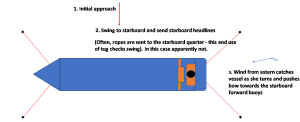The Charity
Aviation
Maritime
Incident at a Conventional Buoy Mooring (CBM) system.

Initial Report
Outline:
A report highlighting the importance of proper communication between all parties during mooring operations.
What the Reporter told us:
The vessel was mooring at a CBM during daylight, with four crew manning the forward mooring station. Two starboard headlines had been sent and were secured to a mooring buoy. A tug was made fast at the centre lead aft (while no tug was provided forward). At the time of the incident, the vessel was being swung to starboard into position, prior to sending the port headlines. Astern propulsion was used to counter the wind, which was blowing from astern, and causing the vessel to drift closer to the forward starboard mooring buoy. At the forward mooring station, winches for the starboard headlines remained in gear, but as the vessel moved astern, they were not paid out quickly enough. As a result of the vessel moving astern, excessive tension was applied on the two headlines, which unfortunately caused both to part in quick succession.
Although there was no injury to the crew on this occasion, it vividly highlights the inadequate communication between the bridge and the forward mooring teams.
Lessons Learned:
- To highlight the need for open and continuous communication between the bridge and mooring stations, this should be fully discussed during the pre-mooring toolbox talk and risk assessment meeting.
- For situational awareness, the bridge team should ALWAYS notify the mooring stations of any intended actions. Similarly, both mooring stations should also provide a continuous status report for the bridge team’s awareness.

Schematic of a Conventional Buoy Mooring System
CHIRP Comment:
Having discussed this report, the Maritime Advisory Board agreed that a lack of communication was central to this incident and that all aspects of the intended operation including hazards should have been covered at the pre-mooring meeting.
Mooring to a CBM requires extreme precision and timing in order to safely conduct the operation. All personnel should be fully aware of the requirements. Sometimes an anchor may be used to effect a turn. This requires a minimum of two people at the anchor station, the windlass operator and the officer in charge. If we now add winchmen running lines to the buoys we are rapidly running out of available personnel. Therefore, it can be seen that it is easy to become distracted or preoccupied with one particular task and not keep a full overview of the situation.
And what of the tug? The prevailing weather conditions should have made it clear that the tug would be required to pull astern to check the vessel. In addition, the pull (if on the starboard quarter) could have checked the natural transverse thrust caused by the astern movement.
Above all, if control of the operation had been lost, then releasing the headlines and steaming out may have been the better option.
Report Ends……







